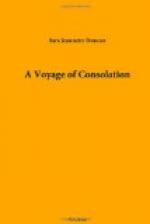“I shouldn’t wonder but what you express the sentiments of all present,” said her father admiringly. “Now is it allowable for us to go down there and make ourselves at home amongst those antique pillars, or have we got to take the show in from here?”
“No, Malt,” said the Senator, helping the ladies out, “I can’t say I agree with you. It’s a dead city, that’s what it is, and for my part I’ve never seen anything so impressive.”
“Mr. Wick,” remarked Miss Callis, “has not visited Philadelphia.”
“Well, for a municipal cemetery,” returned Mr. Malt, “it’s pretty uncared for. If there was any enterprise in this capital it would be suitably railed in with posts and chains, and a monument inscribed ’Here lies Rome’s former greatness’ or something like that. But the Italians haven’t got a particle of go—I’ve noticed that all through.”
We went down the wooden stair, a century at a step, and presently walked and talked, we seven Americans, in that elder Rome that most people know so much better than the one with St. Peter’s and the Corso, because of the clinging nature of those early impressions which we construe for ourselves with painful reference to lists of exceptions. We all felt that it was a small place to have had so much to say to history, and were obliged to remind ourselves that we weren’t looking at the whole of it. Poppa acknowledged that his tendency to compare it unfavourably, in spite of the verdict of history, with Chicago was checked by a smell from the Cloaca Maxima, which proved that the Ancient Romans probably enjoyed enteric and sewer gas quite as much as we do, although under names that are to be found only in dictionaries now. Mrs. Malt said the place surprised her in being so yellow—she had always imagined pictures of it to have been taken in the sunset, but now she saw that it was perfectly natural. Acting upon Mr. Malt’s advice, we did not attempt to identify more than the leading features, and I remember distinctly, in consequence, that the temple of Castor had three columns standing and the temple of Saturn had eight, while of the Basilica Julia there was nothing at all but the places where they used to be. Mrs. Malt said it made her feel quite idolatrous to look at them, and for her part she couldn’t be sorry they had fallen so much into decay—it was only right and proper. This launched Mr. and Mrs. Malt and my parents upon a discussion which threatened to become unwisely polemic if Emmeline had not briefly decided it in favour of Christianity.




